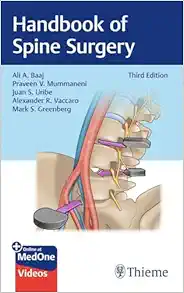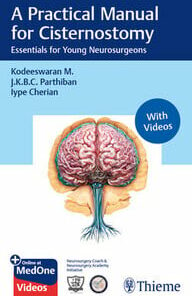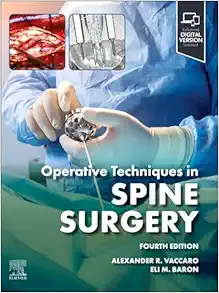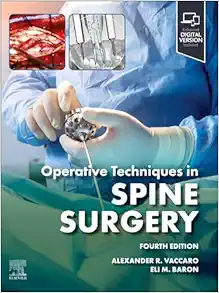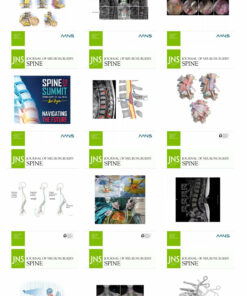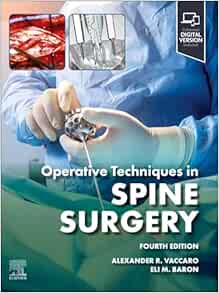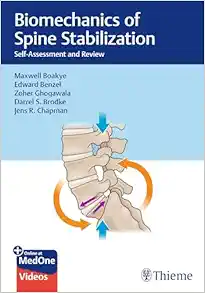- Hardcover: 256 pages
- Publisher: Thieme; 1 edition (August 9, 2019)
- Language: English
- ISBN-10: 1626237328
- ISBN-13: 978-1626237322
Sagittal Balance of the Spine: From Normal to Pathology: A Key for Treatment Strategy 1st Edition PDF
$15
by Pierre Roussouly (Editor), João Pinheiro-Franco (Editor), Hubert Labelle (Editor), Martin Gehrchen (Editor)
- The biomechanics of sagittal balance including spine modeling, primary parameters, spinal curves segmentation, and lumbar lordosis classification
- The role of sagittal balance in low back pain and degeneration, with discussion of spinal orientation and the contact forces theory, spinal degeneration associated with spinopelvic morphotypes, and compensatory mechanisms
- Comprehensive analysis of the relationship between sagittal imbalance and isthmic lysis spondylolisthesis, degenerative spondylolisthesis, Scheuermann’s kyphosis, adolescent idiopathic scoliosis, and adult scoliosis
- Posterior and anterior treatment approaches – from spinal fixation and spinal fusion – to spinal osteotomy techniques and management of surgical failure
Sagittal Balance of the Spine: From Normal to Pathology: A Key for Treatment Strategy 1st Edition PDF
Unique resource from internationally renowned experts details the key role of sagittal spine balance
Through evolution, human verticality became associated with a wide range of normal pelvic shapes and associated pelvic incidence angles (PIs). While all types of sagittal alignment generally provide adequate support to young adults, age, stress, and related degeneration can progressively lead to sagittal imbalance and contribute to various spinal pathologies.
Sagittal Balance of the Spine by Pierre Roussouly, João Luiz Pinheiro-Franco, Hubert Labelle, Martin Gehrchen, and a cadre of esteemed international contributors focuses on the importance of sagittal alignment and spino-pelvic shape identification in clinical practice. Offering the most comprehensive text on sagittal balance to date, this state-of-the-art, richly illustrated book fills a void in the literature, offering clinical pearls throughout seven sections and 24 chapters.
Key Highlights
Product details |
Related Products
Neurosurgery books PDF
Neurology and Neurosurgery: 200 Sbas for Medical Students (Original PDF from Publisher)
Neurosurgery books PDF
Handbook of Spine Surgery, 3rd Edition + Videos (Original PDF from Publisher)
Neurosurgery books PDF
Spinal Deformities: The Comprehensive Text, 2nd edition (Original PDF from Publisher+Videos)
Neurosurgery books PDF
Journal of Neurosurgical Anesthesiology 2024 Full Archives (True PDF)
Neurosurgery books PDF
Neurosurgery books PDF
Neurosurgery books PDF
Operative Techniques: Spine Surgery, 4th edition (Original PDF from Publisher)
Neurosurgery books PDF
Neurosurgery books PDF
Anterior Controllable Antedisplacement and Fusion: Technique in Spinal Surgery (EPUB)
Neurosurgery books PDF
Neurosurgery books PDF
Neurosurgery books PDF
Neurosurgery books PDF
Neurosurgery books PDF
Biomechanics of Spine Stabilization: Self-Assessment and Review (Original PDF from Publisher)
Neurosurgery books PDF
Neurosurgery books PDF
Neurosurgery books PDF
Lyftogt Perineural Injection Treatment: How to Treat Peripheral Nerve Pain
Neurosurgery books PDF
Neurosurgery books PDF
Spinal Deformities: The Comprehensive Text 2nd Edition PDF & VIDEO
Neurosurgery books PDF
Neurosurgery books PDF
Neurosurgery books PDF
Journal Of Neurosurgery Pediatrics 2023 Full Archives (True PDF)
Neurosurgery books PDF
Journal Of NeuroInterventional Surgery 2023 Full Archives (True PDF)
Neurosurgery books PDF
External Ventricular And Lumbar Drains: Indications, Procedures, And Patient Care (EPUB)
Neurosurgery books PDF
Journal Of Neurosurgical Anesthesiology 2023 Full Archives (True PDF)
Neurosurgery books PDF
Neuroimaging Clinics Of North America 2023 Full Archives (True PDF)
Neurosurgery books PDF
Neuroimaging Clinics Of North America 2022 Full Archives (True PDF)
Neurosurgery books PDF
Neurosurgery Clinics Of North America 2023 Full Archives (True PDF)
Neurosurgery books PDF
Neurosurgery Clinics Of North America 2022 Full Archives (True PDF)
Neurosurgery books PDF
An Inner Approach To Cranial Osteopathy (Original PDF From Publisher)
Neurosurgery books PDF
Neurosurgery books PDF
Neurosurgery books PDF
Neurosurgery books PDF
Neurosurgery books PDF
Neurosurgery books PDF
Neurosurgery books PDF
Neurosurgery books PDF
Manual De Neurocirugia (2 Volumenes, 9ª Edicion) (High Quality Image PDF)
Neurosurgery books PDF
Neurosurgery books PDF
Neurosurgery books PDF
Neurosurgery books PDF
Intracranial Arteriovenous Malformations: Essentials for Patients and Practitioners
Neurosurgery books PDF
Neuro-Oncology Compendium for the Boards and Clinical Practice
Neurosurgery books PDF
Skull Base Reconstruction: Management of Cerebrospinal Fluid Leaks and Skull Base Defects
Neurosurgery books PDF
Neurosurgery books PDF
Neurosurgery books PDF
Neurosurgery books PDF
Master Techniques in Orthopaedic Surgery: The Spine, 4th Edition
Neurosurgery books PDF
Ultrasonography of the Prenatal Brain, Third Edition Original PDF
Neurosurgery books PDF
Neurosurgery books PDF
Neurosurgery books PDF
Neurosurgery books PDF
Neurosurgery books PDF
Neurosurgery books PDF
Neurosurgery books PDF
Surgery of the Cerebellopontine Angle, 2nd Edition (Original PDF from Publisher)
Neurosurgery books PDF
Surgical Nuances of Head Injury (Original PDF from Publisher)
Neurosurgery books PDF
Neurosurgery Updates Critical Care for Neurosurgeons Volume 3 (Original PDF from Publisher)
Neurosurgery books PDF
ASSI Operation Theater Manual for Spine Surgery (Original PDF from Publisher)
Neurosurgery books PDF
Journal of Neurosurgery: Spine 2022 Full Archives (True PDF)
Neurosurgery books PDF
Journal of Neurosurgery: Pediatrics 2022 Full Archives (True PDF)
Neurosurgery books PDF
Manual de Neurocirurgia, 8th Edition (Original PDF from Publisher)
Neurosurgery books PDF
The Comprehensive Neurosurgery Board Preparation Book: Illustrated Questions and Answers (EPUB)
Neurosurgery books PDF
Neurosurgical Operative Atlas: Spine and Peripheral Nerves, 3rd Edition (EPUB)
HEAD AND NECK SURGERY & OTOLARYNGOLOGY
Atlas of Facial Nerve Surgeries and Reanimation Procedures Original PDF
Neurosurgery books PDF
Neurosurgery books PDF
Carotid Treatment: Principles and Techniques, 3rd Edition 2023 Original PDF
Neurosurgery books PDF
Condutas em Neurocirurgia: Fundamentos Práticos – Crânio (EPUB)
Neurosurgery books PDF
Neurosurgery books PDF
Neurosurgery books PDF
Transnasal Endoscopic Skull Base and Brain Surgery: Surgical Anatomy and its Applications (EPUB)
Neurosurgery books PDF
Surgery of the Thoracic Spine: Principles and Techniques (EPUB)
Neurosurgery books PDF
Meningiomas of the Skull Base: Treatment Nuances in Contemporary Neurosurgery (EPUB)
Neurosurgery books PDF
Cirurgia Endoscópica da Coluna Vertebral, 2nd Edition (Original PDF from Publisher)





